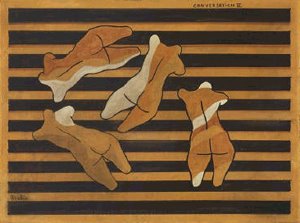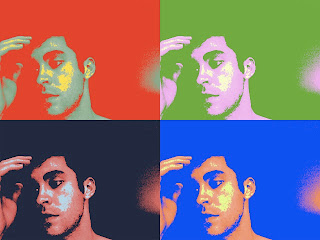Dada with Dad-a.

Today I had the privilege of spending the afternoon with my father moseying around MOMA. After spending the morning in Brooklyn with friends I was eagerly anticipating the Dada exhibit following a brunch-time rave. It has been a little over two months since I was last at MOMA and since then it seems as if everything has changed with the season. Now normally I wouldn't choose to spend my one day off standing on my feet but something about MOMA is always so fulfilling. It always leaves me feeling inspired and yearning to create.
I felt today as if I was viewing things through a new pair of eyes. Sometimes it just takes the right piece to change the way you look at a certain medium and for me that was how I felt about sculpture and video installations. These are both forms that I have always viewed with a sort of passive disinterest, pausing for a moment to see if any lightning struck and then passing like Goldilocks if something wasn't "just right". Especially with video installations I have always felt they were so pretentious and had little if anything to offer me. Today my view was really tested when I found myself mesmerized to the point of hypnosis by two installations by Douglas Gordon.
This artist is one of the primary exhibits being featured at the moment and is described in the pamphlet as an artist who "draws on the discrepancy between our immediate interactions with the work in the exhibition space and the old associations the work triggers in our minds. Gordon sculpts time into a physical experience." One of his pieces titled "24 Hour Psycho" which I had the least amount of interest in of all takes Alfred Hitchcock's film and slows it down so that it plays only one time in a 24 Hour period. This to me is an example of video installations pretentiousness....I just don't really care. When I walked into the next room and into the darkness the light in my eyes was ignited.
Music escapes from speakers lining the back wall and three projections of the same video appear on the opposite wall. The one in the center is projected normally with the two sandwiching it are flipped upside-down. It is a simple filming of a conductor and his face and hands being focused on individually. By zooming in on each part individually there is a sort of disconnection from the music while at the same time it embodies the music as if it were a dance. It provided such a rush watching his hands swoop in and out, pausing at times to draw out the music and then sweeping off again like snowflakes in a flurry. I hope to have the chance to go back to view it again.
The next installation of his consisted of two large screens hanging at different diagonals in the center of the room. On these screens there was a projection of an elephant in a room similar to the one we were standing in. It showed the elephant playing in the room and films it while rotating around. As a viewer walks 360 degrees around the room and the camera itself is spinning it creates the feeling of multiple turntables going in different directions. Viewing this mammoth creature in an empty white room had an intimate quality while never feeling captive even though the animal was enclosed by four walls. Zooming up close to the eyes of the elephant it takes on a sudden sensitive human side which was a little startling. Like the pamphlet said, it was taking my preconceived ideas of something and testing them.

Equally startling but in a completely different realm was the Dada exhibit that has taken over the top floor of MOMA. I went into this exhibit with almost no knowledge of the Dada movement and what it meant. After viewing this collection of post World War One art collected from six key cities I cannot wait to learn more. As a movement Dada is more interesting to me for what it signified than for the art it created. A huge amount of the work consists of collage, found objects, sculpture and similar merging of different forms. As a movement it is said to have been a rejection of the nationalism that was taking over the art world and the abstractions of the modern art movement. It also was one of the first global artistic movements that linked artists from all over the world. At its center seems to be the question "What exactly is art?" and that question is tested by such examples as a urinal with painting on it and a hanger mobile sculpture among other things. Viewing these works, which were created in the first two decades of the 20th century, shows just how influential the Dada movement was. Much of it looks like it was created just yesterday. The exhibit was packed and I didn't get the chance to experience it fully but on first viewing the art of Francis Picabia (pictured above) really caught my eye. Will report more when I have a few more opportunities to observe the Dadaisms.



0 Comments:
Post a Comment
<< Home